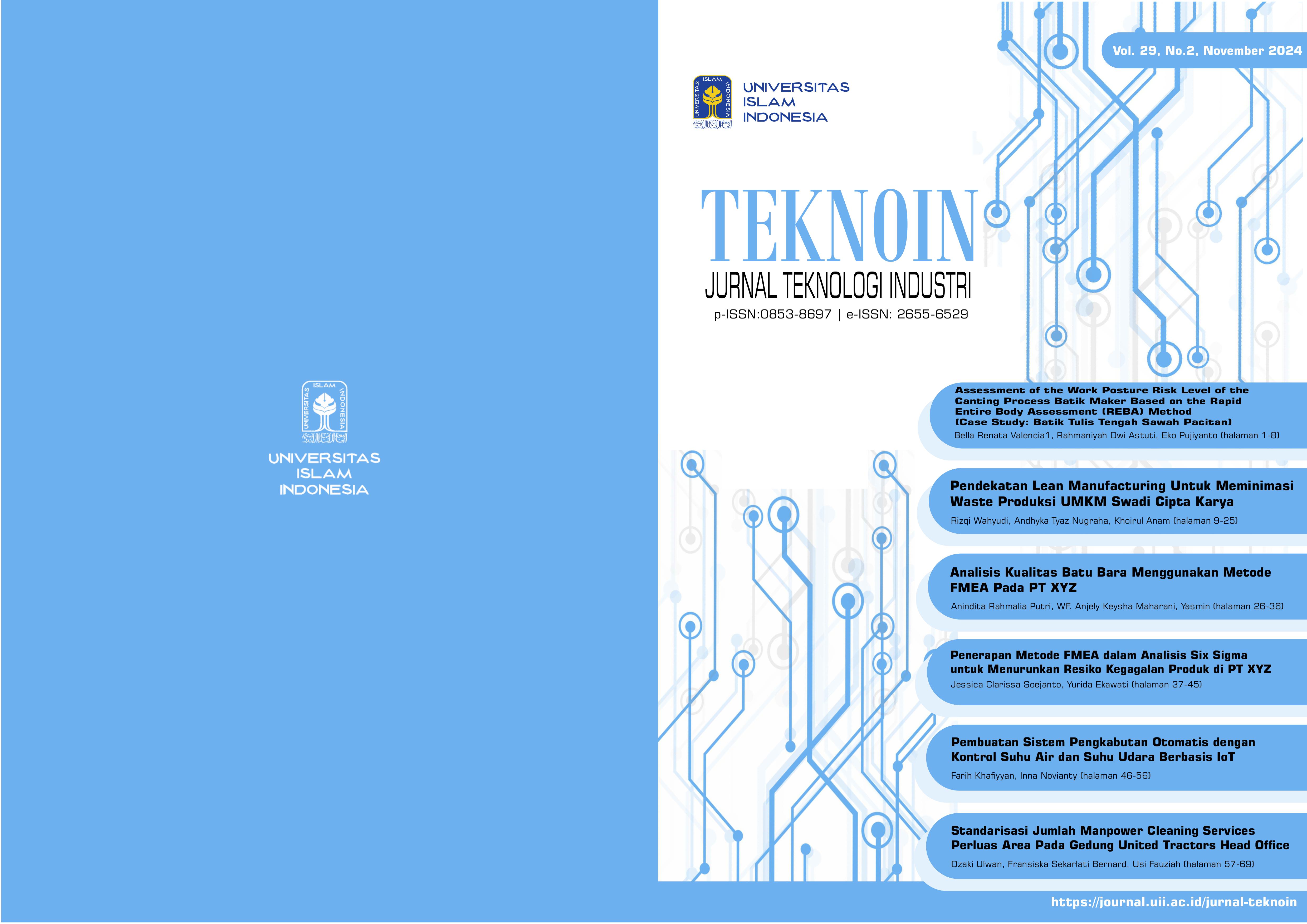Main Article Content
Abstract
In the era of intense global competition, companies must have the right strategy to achieve competitive advantage, one of which is by developing and managing human resources (HR) effectively and efficiently. In the United Tractors Head Office Building, distribution of cleaning services from PT. This disproportionate Mitra Bakti UT shows that the workload is not distributed evenly. Therefore, this research aims to measure the cleaning service workload in the United Tractors Head Office Building and determine the optimal number of workers needed using the Full Time Equivalent (FTE) method. and Work Load Analysis (WLA). In this research, the data taken is in the form of activities and the total hours of completion of these activities. By calculating the workload, you can see the correct number of celaning services and can determine the area of each worker with an even workload. By using the Work Load Analysis method, the results are that the workload for cleaning services work is 250% compared to the existing workload of only 192%. The manpower workload is more balanced, previously the highest value was 104% and the lowest value was 43%, after calculating the workload it became evenly distributed with a value of 83%. After calculating the number of cleaning services from 20 people to 24 people and the area of each manpower is 609 m^2.
Keywords
Article Details
Copyright (c) 2024 Dzaki Ulwan

This work is licensed under a Creative Commons Attribution-ShareAlike 4.0 International License.
Authors who publish with this journal agree to the following terms:
- Authors retain copyright and grant the journal right of first publication with the work simultaneously licensed under a Creative Commons Attribution License that allows others to share the work with an acknowledgement of the work's authorship and initial publication in this journal.
- Authors are able to enter into separate, additional contractual arrangements for the non-exclusive distribution of the journal's published version of the work (e.g., post it to an institutional repository or publish it in a book), with an acknowledgement of its initial publication in this journal.
- Authors are permitted and encouraged to post their work online (e.g., in institutional repositories or on their website) prior to and during the submission process, as it can lead to productive exchanges, as well as earlier and greater citation of published work (See The Effect of Open Access).
References
Adawiyah, W. (2013). Analisis beban kerja sumber daya manusia dalam aktivitas produksi komoditi sayuran selada (studi kasus : cv spirit wira utama). Program Studi Manajemen Institut Pertanian Bogor
Agus, S., Mahbubah, N. A., & Andesta. (2018). Penerapan metode workload analysis guna menganalisis beban kerja sebagai pertimbangan pemberian intensif pada operator UD. Karya Mandiri. Jurnal Universitas Muhamaddiyah Gresik, 53(9).
Chan, Pratiwi, Sanjaya dan Rahardjo. 2018. Analisis Beban Kerja Pada Cleaning Services di PT. XYZ Dengan Metode Full Time Equivalent. Fakultas Teknologi Industri, Program Studi Teknik Industri, Universitas Kristen Petra Jl. Siwalankerto 121-131, Surabaya 60236.
Kamala, V., Malliga, P. and Priyanka, G. M.. 2016. Criteria Based Ergonomic Assessment in a Manufacturing Industry. IEEE International Conference on Industrial Engineering and Engineering Management (IEEM), Bali, pp. 238-242.
Marlina, L. (2015). Manajemen Sumber Daya Manusia (SDM) dalam pendidikan. Istinbath, XIV(15), pp. 123–139.
Megbo, et al. 2015. Applications of Full Time Equivalent and Its Implications on Resources Planning in Nigerian Universities. Vol B, No 1.
Prasetya, (2017). Efektivitas Manpower Planning Dengan Menggunakan Metode Analisis Beban Kerja (Work Load Analysis) Berdasarkan Pendekatan Full Time Equivalent. Jurnal Administrasi Bisnis, Vol. 42 No. 1 Januari 2017.
Rahmat Hermawan, N., & Banjarsari. (2019).Teknik Industri Fakultas Teknik Universitas Galuh Ciamis 46215. 06(01), 91–114.
Ridha, I. R., Bakar, A., & Nugraha, C. (2013). Usulan Kebutuhan Jumlah Tenaga Kerja di Bagian Water Based PT . X Berdasarkan Analisis Beban Kerja
Riyanto, Y., (2010). Metodologi Penelitian Pendidikan.Surabaya : Penerbit SIC
Roidelindho. 2017. PENENTUAN BEBAN KERJA DAN JUMLAH TENAGA KERJA OPTIMAL PADA PRODUKSI TAHU. Jurnal Rekayasa Sistem Industri, Vol. 3, No. 1 November 2017.
Wigjosoebroto, & S. (2003). Ergonomi Studi Gerak Dan Waktu
Wignjosoebroto, S. (1992). Pengantar Teknik & Manajemen Industri. Surabaya : Guna Widya. Zainal, I.Z., & Ramadhanti, R. (2019). Need analysis of non-permanent employees with Full Time Equivalent (FTE) method. E-Jurnal Apresiasi Ekonomi, (7) 267-285.
References
Adawiyah, W. (2013). Analisis beban kerja sumber daya manusia dalam aktivitas produksi komoditi sayuran selada (studi kasus : cv spirit wira utama). Program Studi Manajemen Institut Pertanian Bogor
Agus, S., Mahbubah, N. A., & Andesta. (2018). Penerapan metode workload analysis guna menganalisis beban kerja sebagai pertimbangan pemberian intensif pada operator UD. Karya Mandiri. Jurnal Universitas Muhamaddiyah Gresik, 53(9).
Chan, Pratiwi, Sanjaya dan Rahardjo. 2018. Analisis Beban Kerja Pada Cleaning Services di PT. XYZ Dengan Metode Full Time Equivalent. Fakultas Teknologi Industri, Program Studi Teknik Industri, Universitas Kristen Petra Jl. Siwalankerto 121-131, Surabaya 60236.
Kamala, V., Malliga, P. and Priyanka, G. M.. 2016. Criteria Based Ergonomic Assessment in a Manufacturing Industry. IEEE International Conference on Industrial Engineering and Engineering Management (IEEM), Bali, pp. 238-242.
Marlina, L. (2015). Manajemen Sumber Daya Manusia (SDM) dalam pendidikan. Istinbath, XIV(15), pp. 123–139.
Megbo, et al. 2015. Applications of Full Time Equivalent and Its Implications on Resources Planning in Nigerian Universities. Vol B, No 1.
Prasetya, (2017). Efektivitas Manpower Planning Dengan Menggunakan Metode Analisis Beban Kerja (Work Load Analysis) Berdasarkan Pendekatan Full Time Equivalent. Jurnal Administrasi Bisnis, Vol. 42 No. 1 Januari 2017.
Rahmat Hermawan, N., & Banjarsari. (2019).Teknik Industri Fakultas Teknik Universitas Galuh Ciamis 46215. 06(01), 91–114.
Ridha, I. R., Bakar, A., & Nugraha, C. (2013). Usulan Kebutuhan Jumlah Tenaga Kerja di Bagian Water Based PT . X Berdasarkan Analisis Beban Kerja
Riyanto, Y., (2010). Metodologi Penelitian Pendidikan.Surabaya : Penerbit SIC
Roidelindho. 2017. PENENTUAN BEBAN KERJA DAN JUMLAH TENAGA KERJA OPTIMAL PADA PRODUKSI TAHU. Jurnal Rekayasa Sistem Industri, Vol. 3, No. 1 November 2017.
Wigjosoebroto, & S. (2003). Ergonomi Studi Gerak Dan Waktu
Wignjosoebroto, S. (1992). Pengantar Teknik & Manajemen Industri. Surabaya : Guna Widya. Zainal, I.Z., & Ramadhanti, R. (2019). Need analysis of non-permanent employees with Full Time Equivalent (FTE) method. E-Jurnal Apresiasi Ekonomi, (7) 267-285.
